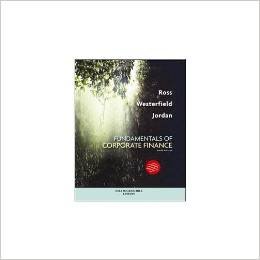
Fundamentals Of Corporate Finance, Tenth Standard Edition
10th Edition
ISBN: 9781121571938
Author: Westerfield, Jordan, 2013 Ross
Publisher: Mcgraw-Hill
expand_more
expand_more
format_list_bulleted
Question
Chapter 16.8, Problem 16.8CCQ
Summary Introduction
To discuss: The differences in the implications of pecking-order and static theory.
Introduction:
The static theory of capital structure states that the borrowing of the company at a certain point where the benefits of tax from an additional dollar in debt is accurately equivalent to the cost, which arises from financial distress of a company. The fundamental element in the pecking-order theory is that the companies desire to utilize the internal financing whenever possible.
Expert Solution & Answer
Want to see the full answer?
Check out a sample textbook solution
Students have asked these similar questions
Compare static theory and pecking order theory.
When we work with the breakeven point, how important is it to understand what a decision variable is? How is it different from a regular variable?
How are Sensitivty Analysis and Scenario Analysis different in details?
Chapter 16 Solutions
Fundamentals Of Corporate Finance, Tenth Standard Edition
Ch. 16.1 - Why should financial managers choose the capital...Ch. 16.1 - What is the relationship between the WACC and the...Ch. 16.1 - What is an optimal capital structure?Ch. 16.2 - Prob. 16.2ACQCh. 16.2 - Prob. 16.2BCQCh. 16.2 - Prob. 16.2CCQCh. 16.3 - What does MM Proposition I state?Ch. 16.3 - What are the three determinants of a firms cost of...Ch. 16.3 - Prob. 16.3CCQCh. 16.4 - What is the relationship between the value of an...
Ch. 16.4 - If we consider only the effect of taxes, what is...Ch. 16.5 - Prob. 16.5ACQCh. 16.5 - What are indirect bankruptcy costs?Ch. 16.6 - Can you describe the trade-off that defines the...Ch. 16.6 - What are the important factors in making capital...Ch. 16.7 - Prob. 16.7ACQCh. 16.7 - What is the difference between a marketed claim...Ch. 16.7 - What does the extended pie model say about the...Ch. 16.8 - Prob. 16.8ACQCh. 16.8 - Why might firms prefer not to issue new equity?Ch. 16.8 - Prob. 16.8CCQCh. 16.9 - Do U.S. corporations rely heavily on debt...Ch. 16.9 - What regularities do we observe in capital...Ch. 16.10 - Prob. 16.10ACQCh. 16.10 - Prob. 16.10BCQCh. 16 - Maximizing what will maximize shareholder value?Ch. 16 - What is most closely related to a firms use of...Ch. 16 - Give an example of a direct cost of bankruptcy.Ch. 16 - Prob. 16.7CTFCh. 16 - Prob. 1CRCTCh. 16 - Prob. 2CRCTCh. 16 - Optimal Capital Structure [LO1] Is there an easily...Ch. 16 - Observed Capital Structures [LO1] Refer to the...Ch. 16 - Financial Leverage [LO1] Why is the use of debt...Ch. 16 - Homemade Leverage [LO1] What is homemade leverage?Ch. 16 - Prob. 7CRCTCh. 16 - Prob. 8CRCTCh. 16 - Prob. 9CRCTCh. 16 - Prob. 10CRCTCh. 16 - Prob. 1QPCh. 16 - Prob. 2QPCh. 16 - Prob. 3QPCh. 16 - Prob. 4QPCh. 16 - Prob. 5QPCh. 16 - Prob. 6QPCh. 16 - Prob. 7QPCh. 16 - Prob. 8QPCh. 16 - Prob. 9QPCh. 16 - Prob. 10QPCh. 16 - Prob. 11QPCh. 16 - Prob. 12QPCh. 16 - Prob. 13QPCh. 16 - Prob. 14QPCh. 16 - Prob. 15QPCh. 16 - Prob. 16QPCh. 16 - Prob. 17QPCh. 16 - Prob. 18QPCh. 16 - Weighted Average Cost of Capital [LO1] In a world...Ch. 16 - Cost of Equity and Leverage [LO1] Assuming a world...Ch. 16 - Business and Financial Risk [LO1] Assume a firms...Ch. 16 - Stockholder Risk [LO1] Suppose a firms business...Ch. 16 - Prob. 1MCh. 16 - Prob. 2MCh. 16 - Prob. 3MCh. 16 - Prob. 4MCh. 16 - Prob. 5M
Knowledge Booster
Similar questions
arrow_back_ios
arrow_forward_ios
Recommended textbooks for you
 Intermediate Financial Management (MindTap Course...FinanceISBN:9781337395083Author:Eugene F. Brigham, Phillip R. DavesPublisher:Cengage Learning
Intermediate Financial Management (MindTap Course...FinanceISBN:9781337395083Author:Eugene F. Brigham, Phillip R. DavesPublisher:Cengage Learning Cornerstones of Cost Management (Cornerstones Ser...AccountingISBN:9781305970663Author:Don R. Hansen, Maryanne M. MowenPublisher:Cengage Learning
Cornerstones of Cost Management (Cornerstones Ser...AccountingISBN:9781305970663Author:Don R. Hansen, Maryanne M. MowenPublisher:Cengage Learning

Intermediate Financial Management (MindTap Course...
Finance
ISBN:9781337395083
Author:Eugene F. Brigham, Phillip R. Daves
Publisher:Cengage Learning

Cornerstones of Cost Management (Cornerstones Ser...
Accounting
ISBN:9781305970663
Author:Don R. Hansen, Maryanne M. Mowen
Publisher:Cengage Learning